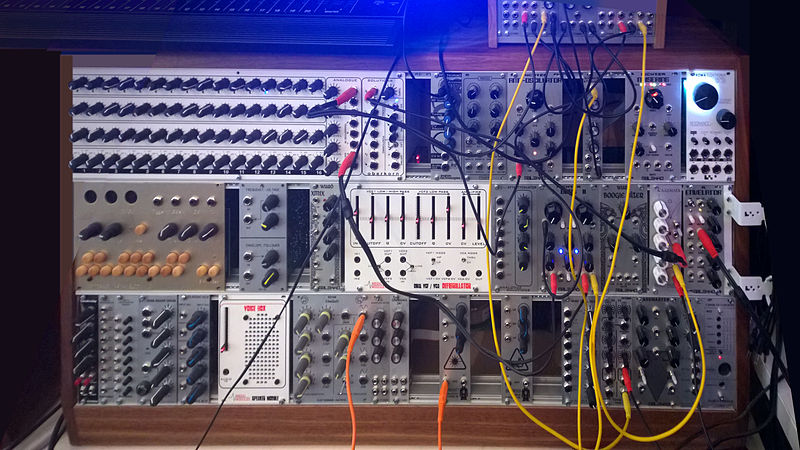Granular synthesis is the operative force behind many plugins and DAW functions we use all the time. When it was first introduced, it was incredibly CPU heavy and confined to offline processing only. Now we have incredibly quick processing speeds which allow us to run complex plugins and virtual instruments almost seamlessly. Meaning, we can take advantage of granular synthesis whether we’re aware of it or not!
Most commonly, you’ll find granular synthesis in pitch correction or speed manipulation software like Auto-Tune or Melodyne, which many of use all the time.
SEE ALSO: Best Stereo Imaging Plugins
SEE ALSO: What Is Stereo Imaging
SEE ALSO: What Is Phantom Power
What is Granular Synthesis?
In short, it’s a method of sound synthesis operating on the “microsound” scale. Microsounds are those which are longer than musical notes and shorter than samples—each piece is somewhere between 1 and 50 ms long.
Granular synthesis is based on the same principles as sampling, but instead of playing back samples regularly, it chops them up into what are referred to as “grains.” These grains, we mentioned, are anywhere between 1 and 50 ms in length, and can be manipulated by a number of parameters. For example, grains can be layered on top of one another, or played at different speeds, phases, frequencies, and levels.
When you alter the various parameters of grains, you can create a huge number of different sounds. Playback speed is also a crucial factor, with lower ones resulting in a kind of soundscape, and higher ones creating audible pitches with an unusual timbre.
Grains
A grain, as we’ve introduced, is a tiny chunk of sound, somewhere between 1 and 50 ms long, though other sources have described it as having a duration of 10-50 or 1-100 ms. Grains can be further broken down into its constituent parts; namely, the envelope and the “content.”
A grain’s envelope is manipulated to ensure there are no clicks, pops, crunches, distortion, or other unpleasant artifacts at the beginning and end of the sample.
A grain’s “content” can simply be described as audio, which is derived from any source, whether it be a sine wave, square wave, audio sample, or anything else.
Wavelet Synthesis: Similar But Different!
Wavelet synthesis is related to granular synthesis, though it’s a bit more precise in definition and principle, and more restrictive in practice. Wavelet synthesis is optimized for “better” pitch shifting and reproduction than granular synthesis, though it is significantly slower when trying to work in a real-time situation.
Software Using Granular Synthesis
The following are a list of plugins, DAW functions, and instruments that use granular synthesis to achieve their functions and sounds.
- Tempo Warping in Ableton
- Grain Delay in Ableton
- Granulator II in Ableton
- Absynth by Native Instruments
- Kontakt by Native Instruments
- Reaktor by Native Instruments
- Alchemy in Logic Pro X
- Flextime in Logic Pro X
- Arkana Synth by Quadelectra
- Auto-Tune by Antares
- Dynamic Delay by iZotope
- Fruity Granulizer in FL Studio
- Granite; an AU/VST/Standalone plugin
- Granular Lab by Amazing Noises – Max for Live
- Malström by Propellerheads
- Melodyne by Celemony
- Omnisphere 2 by Spectrasonics
- Elastic Audio in Avid Pro Tools
Hardware Explorations of Granular Synthesis
There are a number of modular synthesizers available in the Eurorack format, all of which explore the possibilities of granular synthesis without a computer.
- ADM02 Grainshift by Audio Damage
- Clouds by Mutable Instruments
- g0 by Mungo Enterprises
- Grains by Ginko Synthese
- GXN by Mordax Systems
- grandPa by Bastl Instruments
- Nebulae by Qu-Bit Electronix
- Particle Granular Delay by Red Panda Lab
- Morphagene by Make Noise
Summary
To sum things up, granular synthesis is a means of chopping up audio into very small constituent parts. Each of these parts is called a “grain,” anywhere between 1 and 100 ms long. Every grain has its own set of parameters, including frequency, speed, envelope, and level.
SEE ALSO: HOW FM SYNTHESIS WORKS
SEE ALSO: Best Resources for Drum Loops in 2021
SEE ALSO: Monitor Isolation Pads | Home Studio Accessories
Grains can be layered on top of one another, or played back together at different speeds, levels, frequencies, and the like. When used musically and at slower playback speeds, granular synthesis typically creates a soundscape that many users have referred to as a “cloud” of sound. At higher playback speeds, pitches with strange timbres are determinable.
A variety of plugins, virtual instruments, and DAW functions all make use of the granular synthesis principle. Common ones are pitch correction/manipulation software like Auto-Tune and Melodyne, and DAW functions that manipulate time/speed, such as Elastic Audio in Pro Tools or Tempo Warping in Ableton.
Resources
Wikipedia – “Granular Synthesis”
